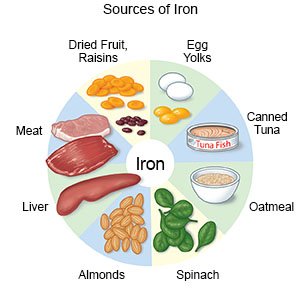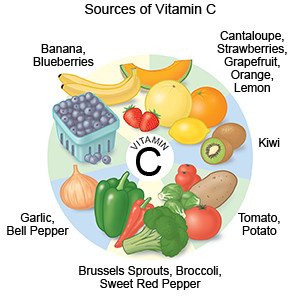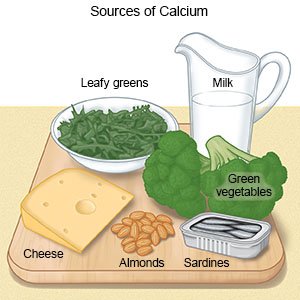Iron Rich Diet
Medically reviewed by Drugs.com. Last updated on Sep 23, 2025.
What is an iron-rich diet?
An iron-rich diet includes foods that are good sources of iron. People need extra iron during childhood, adolescence (teenage years), and pregnancy. Iron is a mineral that your body needs to make hemoglobin. Hemoglobin is part of your blood and helps carry oxygen from your lungs to the rest of your body. Eat iron-rich foods and vitamin C every day to prevent iron deficiency anemia. Iron deficiency anemia can lead to other health problems in adults and growth or development problems in children.
How much iron do I need each day?
- Males:
- 1 to 3 years old: 7 mg
- 4 to 8 years old: 10 mg
- 9 to 13 years old: 8 mg
- 14 to 18 years old: 11 mg
- 19 years and older: 8 mg
- Females:
- 1 to 3 years old: 7 mg
- 4 to 8 years old: 10 mg
- 9 to 13 years old: 8 mg
- 14 to 18 years old: 15 mg
- 19 to 50 years: 18 mg
- Over 51 years old: 8 mg
- Pregnant women: 27 mg
Which foods contain iron?
- Meat, fish, and poultry are good sources of iron. They contain heme iron, a form of iron that your body absorbs very well. Fruit, vegetables, eggs, and grains such as pasta, rice, and cereal also contain iron. They contain nonheme iron, a form of iron that is not absorbed as well as heme iron. You can absorb more iron from these foods by eating a food that is high in vitamin C at the same time. You can also absorb more nonheme iron by eating a food from the meat, fish, and poultry group at the same time.
- Fish and shellfish contain some mercury, a metal that can be harmful. Children and unborn babies are at higher risk for harm caused by mercury. Children and pregnant women should avoid eating fish high in mercury, such as shark and swordfish. They should also eat only fish that are lower in mercury, such as salmon, canned light tuna, and catfish. Limit the amount of low-mercury fish and shellfish you eat to less than 12 ounces per week.
Related medications
What are some iron-rich foods?
- Foods that contain 2 mg or more per serving:
- 3 ounces of cooked beef (chuck, eye of round) or cooked turkey (dark meat)
- ½ cup of beans (black, kidney, or lentil, or soybeans)
- ½ cup of tofu
- 1 medium baked potato
- 1 cup of cooked artichoke or cooked spinach
- ¾ cup of instant oatmeal
- 1 cup of corn flakes
- Foods that contain 1 to 2 mg per serving:
- 3 ounces of chicken
- 3 ounces of pork
- 3 ounces of turkey (light meat)
- 3 ounces of light tuna
- ½ cup of seedless, packed raisins
- 1 slice of whole-wheat or white bread
 |
What are good sources of vitamin C?
Eat a serving of vitamin C with any iron-rich food to help your body absorb more iron. The following fruits and vegetables are good sources of vitamin C:
- 1 cup of fresh orange juice (124 mg) or pink grapefruit juice (83 mg)
- 1 cup of strawberries (106 mg)
- 1 cup of diced cantaloupe (68 mg)
- 1 cup of sweet yellow pepper (283 mg)
- 1 cup of fresh, boiled broccoli (116 mg) or cooked brussels sprouts (97 mg)
- 1 cup of kale (53 mg)
- 1 cup of tomato juice (45 mg)
 |
What other guidelines should I follow?
- Tea and coffee can decrease the amount of iron that your body absorbs from iron-rich foods. Drink coffee and tea separately from meals that contain iron-rich foods.
- Have foods and liquids high in calcium separately from iron-rich foods. Calcium prevents iron from being absorbed. Cow's milk and products made from it, such as cheese and yogurt, are high in calcium. Children older than 1 year only need about 24 ounces of cow's milk each day. Other foods high in calcium include leafy greens, green vegetables, almonds, and canned sardines.

Care Agreement
You have the right to help plan your care. Discuss treatment options with your healthcare provider to decide what care you want to receive. You always have the right to refuse treatment. The above information is an educational aid only. It is not intended as medical advice for individual conditions or treatments. Talk to your doctor, nurse or pharmacist before following any medical regimen to see if it is safe and effective for you.© Copyright Merative 2025 Information is for End User's use only and may not be sold, redistributed or otherwise used for commercial purposes.
Further information
Always consult your healthcare provider to ensure the information displayed on this page applies to your personal circumstances.
